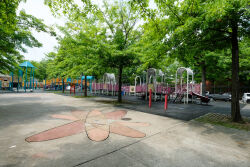Marie Curie Playground
Marie Curie Park
“Life is not easy for any of us. But what of thatΑ We must have perseverance and above all
confidence in ourselves. We must believe that we are gifted for something and that this thing
must be attained.”
-Marie Curie
This playground honors Marie Curie (1867-1934), the noted scientist and first person to win two Nobel Prizes.
Maria Skolodowska-Curie was born in Warsaw, Poland in 1867. She moved to Paris, France in 1891 to study at the Sorbonne (Paris University). Soon after, she joined a research laboratory and in 1898, she and her husband Pierre expanded on Henri Becquerel’s discovery of radioactivity, discovering two new elements, Polonium and Radium. This discovery earned Curie a Nobel Prize in Physics, the first woman to win the prestigious honor. Curie won a second Nobel Prize for Chemistry in 1911, becoming the first person to earn two such awards. Curie died in France in 1934 from leukemia, thought to be caused by exposure to radiation.
Marie Curie Park, located at 46th Avenue and 211th Street in Bayside, is one of many New York parks built under the supervision of Robert Moses (1888–1981), the first person to be Parks Commissioner for the entire City and a legendary figure in New York City politics. Moses, who served as Parks Commissioner from 1934 to 1960, supervised the construction of 255 New York City playgrounds. Marie Curie Playground opened September 6, 1956, as a jointly operated playground at J.H.S. 158. Jointly operated playgrounds are under the jurisdiction of the Board of Education and maintained by Parks, so that parklands serve an adjacent school site’s recreational needs as well as the general public. In 1985 Commissioner Stern renamed the park for Curie.
Council Member Michael J. Abel funded two major capital projects at the site. In 1999 the playing field was reconstructed at a cost of $738,000. The architectural firm of R.G. Roesch designed the renovated playground, which incorporates an atom motif in the spray showers. The hopscotch grid, patterned after a chemistry table, also pays tribute to Curie’s accomplishments in her field. Newly installed plaques list Curie’s achievements and quotes. The second phase of the playground’s reconstruction, a $900,000 project, occurred in 2000, and was funded in part by Council Member Abel and the Department of Transportation, which contributed $100,000 to the project.
Queens features other school playgrounds named for world-renowned scientists, including Sir Isaac Newton (1642-1727) and Galileo Galilei (1564-1642). Today, the park stands both as an inspiration to the schoolchildren of J.H.S. 158 and a place of rest and recreation for people of all ages.
Check out your park's Vital Signs
Clean & Safe
Green & Resilient
Empowered & Engaged Users
Share your feedback or learn more about how this park is part of a
Vital Park System

